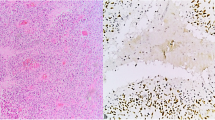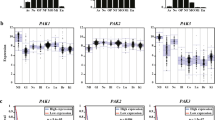Abstract
Pygo2 as a Wnt signaling pathway component has been detected in multiple cancer types. In this study, we identified Pygo2 expression features by immunohistochemistry in 73 central nervous system tumor specimens, in comparison with 14 normal brain tissues and surrounding non-tumorous tissues of tumor. Our study indicated that 59% of the patient tumor specimens exhibited positive Pygo2-staining and increases intensity with the grade of malignancy, especially for WHO grade III and IV gliomas, was observed high level expression, compared with normal brain tissues. Five out of nine WHO grade III anaplastic astrocytomas and seven out of nine WHO grade IV glioblastomas showed Pygo2-positive staining. The analysis of Pygo2 gene expression by quantitative real-time PCR of additional ten fresh patient samples yielded similar results. Further studies performed with stable cell lines in vitro demonstrated that Pygo2 render cells higher proliferation rate, migration and anchorage-independent colony-forming ability in soft agar. Taken together, our studies suggest an important role of Pygo2 in brain tumor progression.




Similar content being viewed by others
Abbreviations
- TCF:
-
T cell factor
- LEF:
-
Lymphoid enhancer binding factor
- PBS:
-
Phosphate-buffered saline
- PHD finger:
-
Plant homeodomain finger
References
Andrews PG, Lake BB, Popadiuk C, Kao KR (2007) Requirement of Pygopus 2 in breast cancer. Int J Oncol 30:357–363
Behin A, Hoang-Xuan K, Carpentier AF, Delattre JY (2003) Primary brain tumours in adults. Lancet 361:323–331
Blagodatski A, Poteryaev D, Katanaev VL (2014) Targeting the Wnt pathways for therapies. Mol Cell Ther 2:28
Buckner JC, Brown PD, O'Neill BP, Meyer FB, Wetmore CJ, Uhm JH (2007) Central nervous system tumors. Mayo Clin Proc 82:1271–1286
Cadigan KM (2002) Wnt signaling--20 years and counting. Trends Genet 18:340–342
De D, Chen A, Wu Z, Lv S, He G, Qi Y (2009) Overexpression of Pygopus2 protects HeLa cells from vinblastine-induced apoptosis. Biol Chem 390:157–165
Dell’Albani P (2008) Stem cell markers in gliomas. Neurochem Res 33:2407–2415
Fathi AR, Roelcke U (2013) Meningioma. Curr Neurol Neurosci Rep 13:337
Fisher JL, Schwartzbaum JA, Wrensch M, Wiemels JL (2007) Epidemiology of brain tumors. Neurol. Clin. 25:867–890 vii
Jessen S, Gu B, Dai X (2008) Pygopus and the Wnt signaling pathway: a diverse set of connections. Bioessays 30:448–456
Kao KR, Popadiuk P, Thoms J, Aoki S, Anwar S, Fitzgerald E, Andrews P, Voisey K, Gai L, Challa S et al (2018) PYGOPUS2 expression in prostatic adenocarcinoma is a potential risk stratification marker for PSA progression following radical prostatectomy. J Clin Pathol 71:402–411
Kramps T, Peter O, Brunner E, Nellen D, Froesch B, Chatterjee S, Murone M, Zullig S, Basler K (2002) Wnt/wingless signaling requires BCL9/legless-mediated recruitment of pygopus to the nuclear beta-catenin-TCF complex. Cell 109:47–60
Lake BB, Kao KR (2003) Pygopus is required for embryonic brain patterning in Xenopus. Dev Biol 261:132–148
Lee Y, Lee JK, Ahn SH, Lee J, Nam DH (2016) WNT signaling in glioblastoma and therapeutic opportunities. Lab Investig 96:137–150
Liu J, Pan S, Hsieh MH, Ng N, Sun F, Wang T, Kasibhatla S, Schuller AG, Li AG, Cheng D et al (2013a) Targeting Wnt-driven cancer through the inhibition of porcupine by LGK974. Proc Natl Acad Sci U S A 110:20224–20229
Liu Y, Dong QZ, Wang S, Fang CQ, Miao Y, Wang L, Li MZ, Wang EH (2013b) Abnormal expression of Pygopus 2 correlates with a malignant phenotype in human lung cancer. BMC Cancer 13:346
Longstreth WT Jr, Dennis LK, McGuire VM, Drangsholt MT, Koepsell TD (1993) Epidemiology of intracranial meningioma. Cancer 72:639–648
Louis DN, Holland EC, Cairncross JG (2001) Glioma classification: a molecular reappraisal. Am J Pathol 159:779–786
McCord M, Mukouyama YS, Gilbert MR, Jackson S (2017) Targeting WNT signaling for multifaceted glioblastoma therapy. Front Cell Neurosci 11:318
Moghbeli M, Abbaszadegan MR, Farshchian M, Montazer M, Raeisossadati R, Abdollahi A, Forghanifard MM (2013) Association of PYGO2 and EGFR in esophageal squamous cell carcinoma. Med Oncol 30:516
Nakamura Y, Umehara T, Hamana H, Hayashizaki Y, Inoue M, Kigawa T, Shirouzu M, Terada T, Tanaka A, Padmanabhan B, Yokoyama S (2007) Crystal structure analysis of the PHD domain of the transcription co-activator Pygopus. J Mol Biol 370:80–92
Ohgaki H, Kleihues P (2005) Epidemiology and etiology of gliomas. Acta Neuropathol 109:93–108
Popadiuk CM, Xiong J, Wells MG, Andrews PG, Dankwa K, Hirasawa K, Lake BB, Kao KR (2006) Antisense suppression of pygopus2 results in growth arrest of epithelial ovarian cancer. Clin Cancer Res 12:2216–2223
Schwab KR, Patterson LT, Hartman HA, Song N, Lang RA, Lin X, Potter SS (2007) Pygo1 and Pygo2 roles in Wnt signaling in mammalian kidney development. BMC Biol 5:15
Stadeli R, Basler K (2005) Dissecting nuclear wingless signalling: recruitment of the transcriptional co-activator Pygopus by a chain of adaptor proteins. Mech Dev 122:1171–1182
Sun P, Watanabe K, Fallahi M, Lee B, Afetian ME, Rheaume C, Wu D, Horsley V, Dai X (2014) Pygo2 regulates beta-catenin-induced activation of hair follicle stem/progenitor cells and skin hyperplasia. Proc Natl Acad Sci U S A 111:10215–10220
Taipale J, Beachy PA (2001) The hedgehog and Wnt signalling pathways in cancer. Nature 411:349–354
Townsley FM, Thompson B, Bienz M (2004) Pygopus residues required for its binding to legless are critical for transcription and development. J Biol Chem 279:5177–5183
Wang ZX, Chen YY, Li BA, Tan GW, Liu XY, Shen SH, Zhu HW, Wang HD (2010) Decreased pygopus 2 expression suppresses glioblastoma U251 cell growth. J Neuro-Oncol 100:31–41
Wang H, Fu J, Xu D, Xu W, Wang S, Zhang L, Xiang Y (2016) Downregulation of Pygopus 2 inhibits vascular mimicry in glioma U251 cells by suppressing the canonical Wnt signaling pathway. Oncol Lett 11:678–684
Watanabe K, Fallahi M, Dai X (2014) Chromatin effector Pygo2 regulates mammary tumor initiation and heterogeneity in MMTV-Wnt1 mice. Oncogene 33:632–642
Wiemels J, Wrensch M, Claus EB (2010) Epidemiology and etiology of meningioma. J Neuro-Oncol 99:307–314
Acknowledgments
This research was supported by The National Natural Science Foundation of China (Grant No. 31501126). We thank Chao Ma, Heng Wei, and Feng Chen for supplying samples and medical assistance.
Author information
Authors and Affiliations
Corresponding author
Electronic supplementary material
Rights and permissions
About this article
Cite this article
Liang, Y., Wang, C., Chen, A. et al. Immunohistochemistry analysis of Pygo2 expression in central nervous system tumors. J. Cell Commun. Signal. 13, 75–84 (2019). https://doi.org/10.1007/s12079-018-0476-0
Received:
Accepted:
Published:
Issue Date:
DOI: https://doi.org/10.1007/s12079-018-0476-0




